The Biostar Racing Z490GTN Review: $200 for Comet Lake mini-ITX
by Dr. Ian Cutress & Gavin Bonshor on June 5, 2020 10:00 AM EST- Posted in
- Motherboards
- Intel
- Biostar
- Z490
- 10th Gen Core
- Comet Lake
- Z490GTN
Gaming Performance
For Z490 we are running using Windows 10 64-bit with the 1909 update.
Grand Theft Auto V
The highly anticipated iteration of the Grand Theft Auto franchise hit the shelves on April 14th 2015, with both AMD and NVIDIA in tow to help optimize the title. GTA doesn’t provide graphical presets, but opens up the options to users and extends the boundaries by pushing even the hardest systems to the limit using Rockstar’s Advanced Game Engine under DirectX 11. Whether the user is flying high in the mountains with long draw distances or dealing with assorted trash in the city, when cranked up to maximum it creates stunning visuals but hard work for both the CPU and the GPU.
For our test we have scripted a version of the in-game benchmark. The in-game benchmark consists of five scenarios: four short panning shots with varying lighting and weather effects, and a fifth action sequence that lasts around 90 seconds. We use only the final part of the benchmark, which combines a flight scene in a jet followed by an inner city drive-by through several intersections followed by ramming a tanker that explodes, causing other cars to explode as well. This is a mix of distance rendering followed by a detailed near-rendering action sequence, and the title thankfully spits out frame time data.
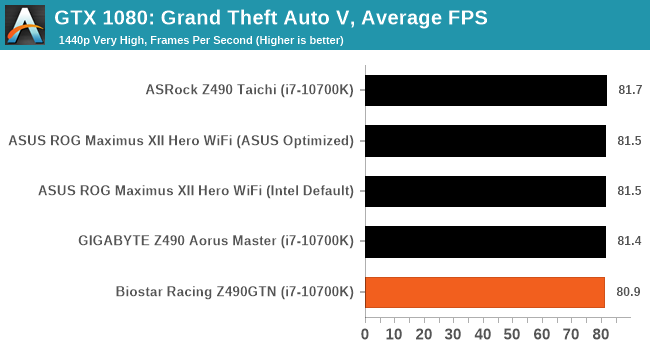
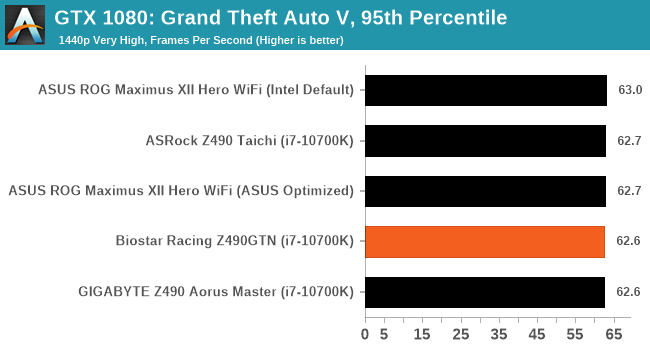
F1 2018
Aside from keeping up-to-date on the Formula One world, F1 2017 added HDR support, which F1 2018 has maintained; otherwise, we should see any newer versions of Codemasters' EGO engine find its way into F1. Graphically demanding in its own right, F1 2018 keeps a useful racing-type graphics workload in our benchmarks.
Aside from keeping up-to-date on the Formula One world, F1 2017 added HDR support, which F1 2018 has maintained. We use the in-game benchmark, set to run on the Montreal track in the wet, driving as Lewis Hamilton from last place on the grid. Data is taken over a one-lap race.
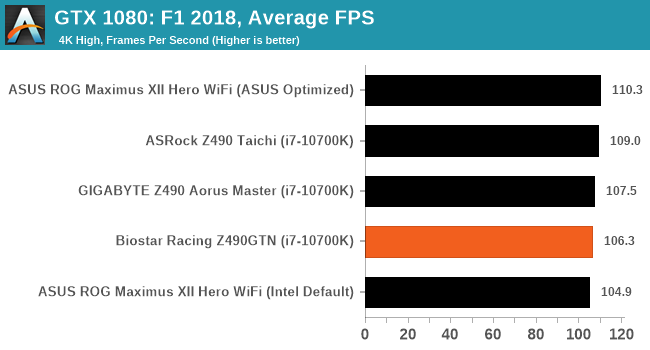
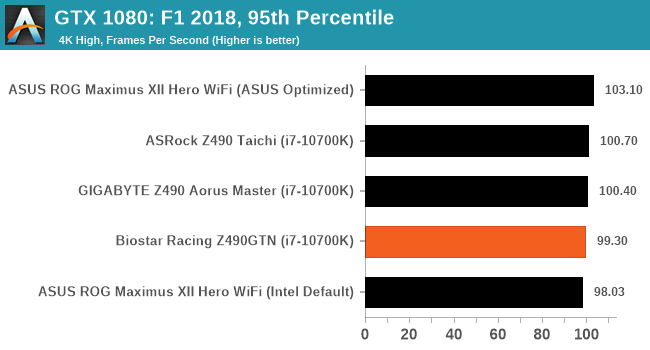
Strange Brigade (DX12)
Strange Brigade is based in 1903’s Egypt and follows a story which is very similar to that of the Mummy film franchise. This particular third-person shooter is developed by Rebellion Developments which is more widely known for games such as the Sniper Elite and Alien vs Predator series. The game follows the hunt for Seteki the Witch Queen who has arose once again and the only ‘troop’ who can ultimately stop her. Gameplay is cooperative centric with a wide variety of different levels and many puzzles which need solving by the British colonial Secret Service agents sent to put an end to her reign of barbaric and brutality.
The game supports both the DirectX 12 and Vulkan APIs and houses its own built-in benchmark which offers various options up for customization including textures, anti-aliasing, reflections, draw distance and even allows users to enable or disable motion blur, ambient occlusion and tessellation among others. AMD has boasted previously that Strange Brigade is part of its Vulkan API implementation offering scalability for AMD multi-graphics card configurations.
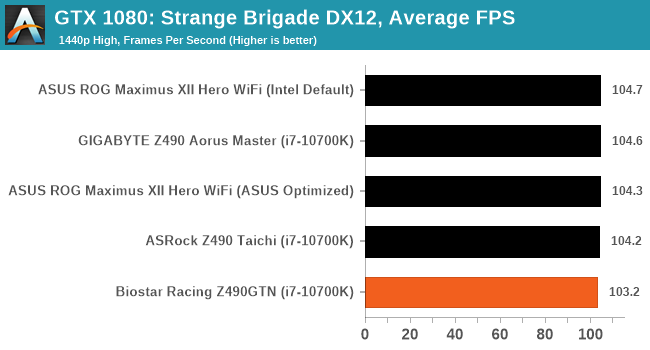














40 Comments
View All Comments
DanNeely - Friday, June 5, 2020 - link
The only chipset on the market that needs active cooling is the AMD 570, because PCIe 4.0 is a power hog.PeachNCream - Sunday, June 7, 2020 - link
Absolutely it will be fine. The vast majority of reasonably designed motherboards need no active cooling anywhere. The few that add them do so because of PCIe 4.0 (currently only an AMD side thing) or fans are slapped onto VRMs to hide poor design decision under the guise of "overclocker friendly voltage regulator cooling enhancements" so people throw more money at supposedly higher margin parts while feeling like they are somehow obtaining greater value that justifies the expenditure. Classic marketing is still alive and well because, despite generations of exposure to it, we haven't gotten much smarter about identifying and coping with it.eastcoast_pete - Friday, June 5, 2020 - link
Thanks Gavin and Ian! Fully agree - way overpriced for what it has and can do.One suggestion, especially for boards that are likely to be used in an HTPC: please include the exact HDMI version supported (with specs) as well as any information on display port and Thunderbolt
capabilities, including, of course, complete absence of such features. Thanks!
As for the current state of affairs with Intel in the HTPC space: they are lucky that AMD has not made Renoir chips available for socketed mini-desktops, or they could kiss that market goodbye.
Slash3 - Friday, June 5, 2020 - link
Socketed Renoir is on the way.lmcd - Friday, June 5, 2020 - link
AM4 seems pretty big for ITX based on the ASRock board I have. This board might be bad but Intel should still have an upper hand, unless Comet Lake is bigger than past socket + chipset pairings?Deicidium369 - Friday, June 5, 2020 - link
has the same HSF hole spacing - so about the same size - it's only 49 additional pinslmcd - Saturday, June 6, 2020 - link
I meant the chipset.eastcoast_pete - Friday, June 5, 2020 - link
Unless I overlooked it, a review of AM4 mini ITX Boards would be interesting, if just for comparison. There are even a couple of x570 boards with PCIe 4.0 for about the price of this board here available, and they include Thunderbolt and WiFi connectivity, and a much better audio. However, my own preference would be for a cheaper B450 or 550 board for about half the price; that's enough for an HTPC setup.Spunjji - Monday, June 8, 2020 - link
How would a smaller socket+chipset give them the upper hand for HTPCs when Renoir offers better CPU performance for a given TDP and markedly superior graphics?AM4 might be "big for ITX", but that's irrelevant if you can still build an ITX system around it.
Operandi - Friday, June 5, 2020 - link
Looks like a pretty weak / inefficient VRM.Speaking of which if you are going to cover the VRM section of a board you need to go into more detail than simply stating the VRM configuration. 6+2 is almost meaningless when the quality of MOSFETS and drivers is what really determines how much power a board is capable of delivering and how efficient it will be. With the specs of the components involved and the layout along with some simple math is pretty easy to ballpark what a board is capable of.